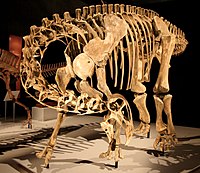
Photo from wikipedia
OBJECTIVES This study seeks to determine if (a) consumption of hard food items or a mixture of food items leads to the formation of premolar or molar microwear in laboratory… Click to show full abstract
OBJECTIVES This study seeks to determine if (a) consumption of hard food items or a mixture of food items leads to the formation of premolar or molar microwear in laboratory capuchin monkeys (Sapajus apella) in one feeding session and (b) rates of microwear formation are associated with the number of food items consumed. MATERIALS AND METHODS Five adult male capuchins were used in two experiments, one where they were fed unshelled Brazil nuts, and the other where they were fed a mixture of food items. Dental impressions were taken before and after each feeding session. Epoxy casts made from those impressions then were used in SEM analyses of rates of microwear formation. Upper and lower premolars and molars were analyzed. Qualitative comparisons were made and Spearman's rank-order correlations used to examine the relationship between rates of microwear formation and number of Brazil nuts consumed. RESULTS Premolars and molars generally showed new microwear in the form of pits and scratches. However, the incidence of those features was low (0-6%). Rates of microwear formation were highest during the consumption of Brazil nuts. DISCUSSION Variations in the rate of microwear formation on the premolars likely reflected patterns of ingestion whereas consistency in the rate of microwear on the molars likely reflected patterns of chewing. While dental microwear formation seemed to be correlated with the number of hard objects consumed, rates did differ between individuals. Differences in results between the two experiments demonstrate some of the limitations in our knowledge of dental microwear formation.
Journal Title: American journal of physical anthropology
Year Published: 2020
Link to full text (if available)
Share on Social Media: Sign Up to like & get
recommendations!